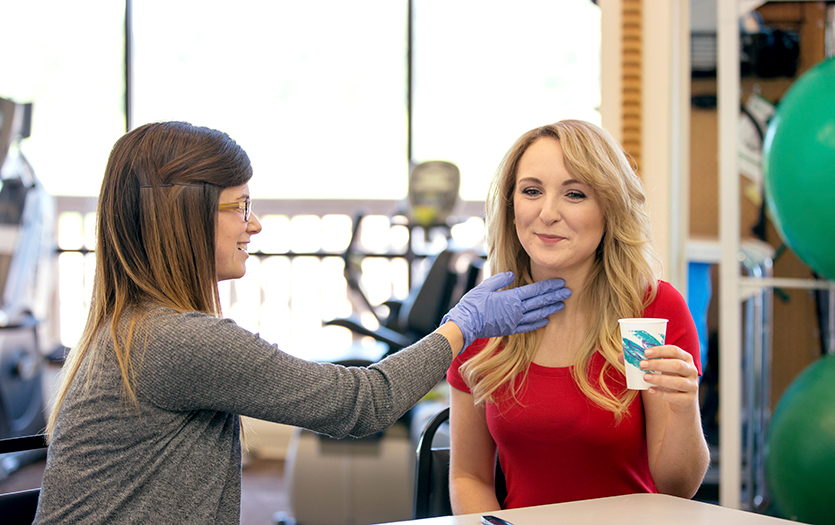
People can have trouble swallowing for many reasons. We covered many of those here. Now Jennifer Witte, SLP, speech-language pathologist, Parkview Therapy Services, walks us through the treatment process.
How do patients with swallowing issues establish care with an SLP?
Most frequently, patients report difficulty with swallowing, which can be due to a variety of reasons and have a wide range of symptoms, to their healthcare provider. Patients can also be observed to have trouble swallowing by a nurse, physical therapist, occupational therapist or even a family member. Once the problem is identified, the provider will write orders for a speech therapy evaluation. At that point, it’s my job to assess the swallow, make recommendations on safe diet and liquids consistencies to eat, how to safely swallow medications, what strategies may need to be used when eating/swallowing and if therapy is recommended to improve the swallow.
What should patients expect with swallow therapy?
It begins with an evaluation. There is more than one way to evaluate a person’s swallow. Clinically: this is where I observe you eating and drinking various textures to identify if I see any signs or symptoms of dysphagia (“Dis’ FAY- Juh”), the medical term for swallowing difficulty. I will also assess the function of your lip, tongue, cheek and throat muscles as part of my assessment. The evaluation may also include trying different strategies for swallowing to help improve the safety and efficiency of your swallow.
During the clinical swallow evaluation, the SLP is looking for clinical signs/symptoms of aspiration. Aspiration is a very important term related to swallowing. It refers to the accidental inhalation of food, liquid, saliva or other materials into the lungs, specifically the airway. Instead of going down the esophagus to the stomach, these materials enter the windpipe (trachea) and can travel into the lungs.
If I suspect you may have aspirated, I will likely recommend a different type of swallow evaluation, an instrumental evaluation. This is when you go to a radiology department in a hospital, and I observe you eating and drinking various textures and watch as the food/liquid moves through your mouth and into your throat (all under X-ray). This is the method that allows me to see if something you intended to swallow ended up entering your airway. This test has more than one name. You may hear it called a modified barium swallow study (MBSS), a rehab swallow study, a video fluoroscopic swallow exam (VFSE) or even a video fluoroscopic swallowing study (VFSS). The procedure is the same the procedure, despite the title. It is performed by an SLP with a radiologist. The SLP’s role is to assess the mechanics of the swallow and make recommendations (to include those described above), while the radiologist’s role is to assess the anatomy and determine if the patient has aspirated.
Some of the recommendations you receive based upon the function of your muscles for swallowing can include changing the consistency of the foods you should eat. There is an international diet level classification for dysphagia diets, so if you are in Bryan, Ohio, someone in Boston, Massachusetts or Italy will understand exactly the foods/textures that are safe (and not safe) on your recommended diet. This is called the international dysphagia diet standardization initiative (IDDSI).
This also includes consistency of liquids. A commercial thickening agent is added to liquids to increase the viscosity of liquids (thicken them), to aide in safe swallowing. The liquids can be “thin” (without thickener), mildly thickened (a nectar consistency, similar to the thick juice in canned fruit), moderately thickened (a honey consistency similar to honey) and extremely thickened (a pudding consistency similar to applesauce).
The SLP may recommend dysphagia therapy as a second step in the treatment plan. This treatment is typically outpatient; however it can be provided during an inpatient hospitalization, inpatient rehabilitation in a rehab hospital or nursing facility, and even at your home via home health therapy.
Dysphagia therapy is determined based upon your specific impairments. The SLP will treat the patient, and often the MBSS is repeated prior to making changes to your diet level, liquid consistency and method of taking medications. Exercise/strengthening of the muscles for lips, tongue, cheek and throat play a large role in dysphagia treatment. Techniques to improve the speed and strength of your swallow will typically be incorporated into your treatment plan.
Education is always provided, along with exercises/techniques to practice at home between your therapy sessions to maximize the progress with your swallow.
Another treatment I am certified to provide is neuromuscular electrical stimulation (NMES). NMES uses electrodes placed on the front of your neck to allow electrical currents to stimulate your throat muscles to increase their strength for a strong swallow. Swallows need to be both fast and strong to safely swallow food/liquids into your esophagus and keep them from entering your airway. This is an evidence-based treatment protocol that has been approved by the FDA for strengthening muscles and retraining nerves involved in swallowing.
The length of therapy varies based upon the severity of your swallowing problem. It can be weeks and maybe months. The number of sessions you have per week can be 2–5 depending on where you are being treated.
What are the typical outcomes for patients once they complete swallow therapy?
Typical outcomes include upgrading the diet level and/or liquid levels to the least restrictive levels while maintaining safety during the swallow. I have worked with patients whose swallow was so impaired that they required a feeding tube to provide their bodies with nutrients, hydration and medications. After swallowing therapy, many of these patients were able to resume an oral diet (even if the texture and consistency was modified). Those patients are often able to have the feeding tube removed!
What measures can people take to prevent swallowing issues?
While preventing swallowing difficulties isn't always possible, especially if caused by underlying medical conditions, there are strategies and techniques to reduce the risk of developing problems or manage existing ones. These strategies include:
Eating and drinking habits
- Eat slowly: Avoid rushing your meals.
-
Take smaller bites: Cut food into smaller pieces to make chewing and swallowing easier.
-
Chew food thoroughly: This prepares the food for a safer swallow.
-
Chew on the stronger side: If one side of your face or mouth is weaker, use the stronger side to chew.
-
Swallow completely before taking another bite: Ensure you have cleared your mouth and throat before the next mouthful.
-
Avoid mixing solids and liquids: Unless advised by a therapist, don't try to wash down solids with sips of liquid.
-
Limit alcohol and caffeine: These can dry out your mouth and throat, potentially making swallowing more difficult.
Dietary modifications
-
Choose soft, moist foods: Examples include scrambled eggs, macaroni and cheese, soups, stews, mashed potatoes and yogurt.
-
Soften hard foods: Dunk foods like toast into liquids like milk or tea.
-
Consider food consistency: Experiment with different textures to see what works best for you and avoid problem foods.
-
Thicken liquids: If advised by a specialist, add a special thickener to thin liquids like water or juice to make them easier to swallow without choking.
Postural adjustments
-
Sit upright while eating and for 30–45 minutes after: This helps reduce the risk of aspiration (food or liquid going down the "wrong way") and assists with food transit.
-
Prop up the head of your bed: This can help manage GERD symptoms, which can contribute to swallowing problems.
-
Consider positional techniques: a speech therapist might teach you techniques like the chin tuck or head turn to improve swallowing safety, especially if you have neurological conditions.
Swallowing exercises
-
Learn exercises from a speech or swallowing therapist: these exercises can help strengthen and coordinate swallowing muscles and re-stimulate nerves.
Examples of exercises include:
-
Effortful swallow: Swallow saliva as hard as possible, squeezing throat muscles.
-
Masako Maneuver: Swallowing with your tongue held between your teeth to strengthen the back of the tongue.
-
Mendelsohn Maneuver: Holding your larynx (voice box) at its highest point during a swallow to improve esophagus opening.
-
Supraglottic swallow: Holding your breath while swallowing, followed by a cough, to protect the airway.
-
Practice exercises regularly: Consistency is key for improving swallowing function.
Lifestyle and medical management
-
Control GERD: If reflux is contributing to your swallowing issues, manage it with antacids and lifestyle changes like weight management and stress reduction.
-
Address underlying medical conditions: Seek treatment for any health conditions contributing to dysphagia, such as neurological disorders, muscle disorders, or infections.
-
See a healthcare professional for persistent symptoms: Dysphagia should be evaluated by a doctor to determine the underlying cause and appropriate treatment.
-
Follow recommendations from an SLP: SLPs are specialists in swallowing disorders and can provide tailored advice and therapy.
While you can reduce the risk of swallowing difficulties by following these strategies, some conditions that cause dysphagia cannot be fully prevented. If you experience symptoms, it's crucial to seek professional help for diagnosis and treatment.
If someone is experiencing swallowing issues, what should they do?
Seek the advice of your primary care provider. Remember that it is not normal to cough/choke/clear throat/sound gurgly after swallowing. Swallowing disorders can be fatal, as choking/obstruction can cause aspiration pneumonia, an infection of the lungs due to bacteria as food/liquids/medications are not absorbed/processed in the lungs as they are in the stomach.
To learn more about the speech therapy program at Parkview, click here.



